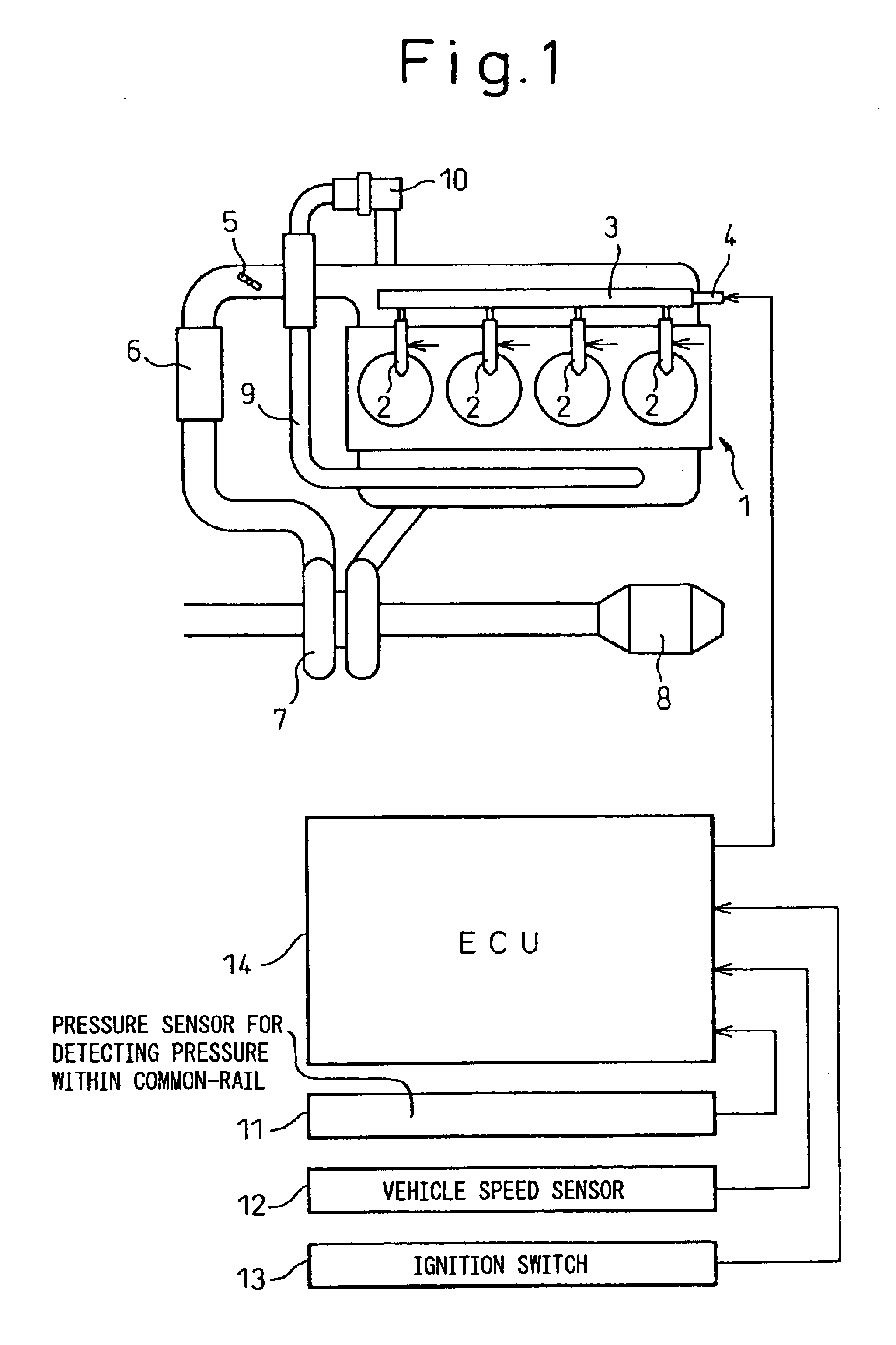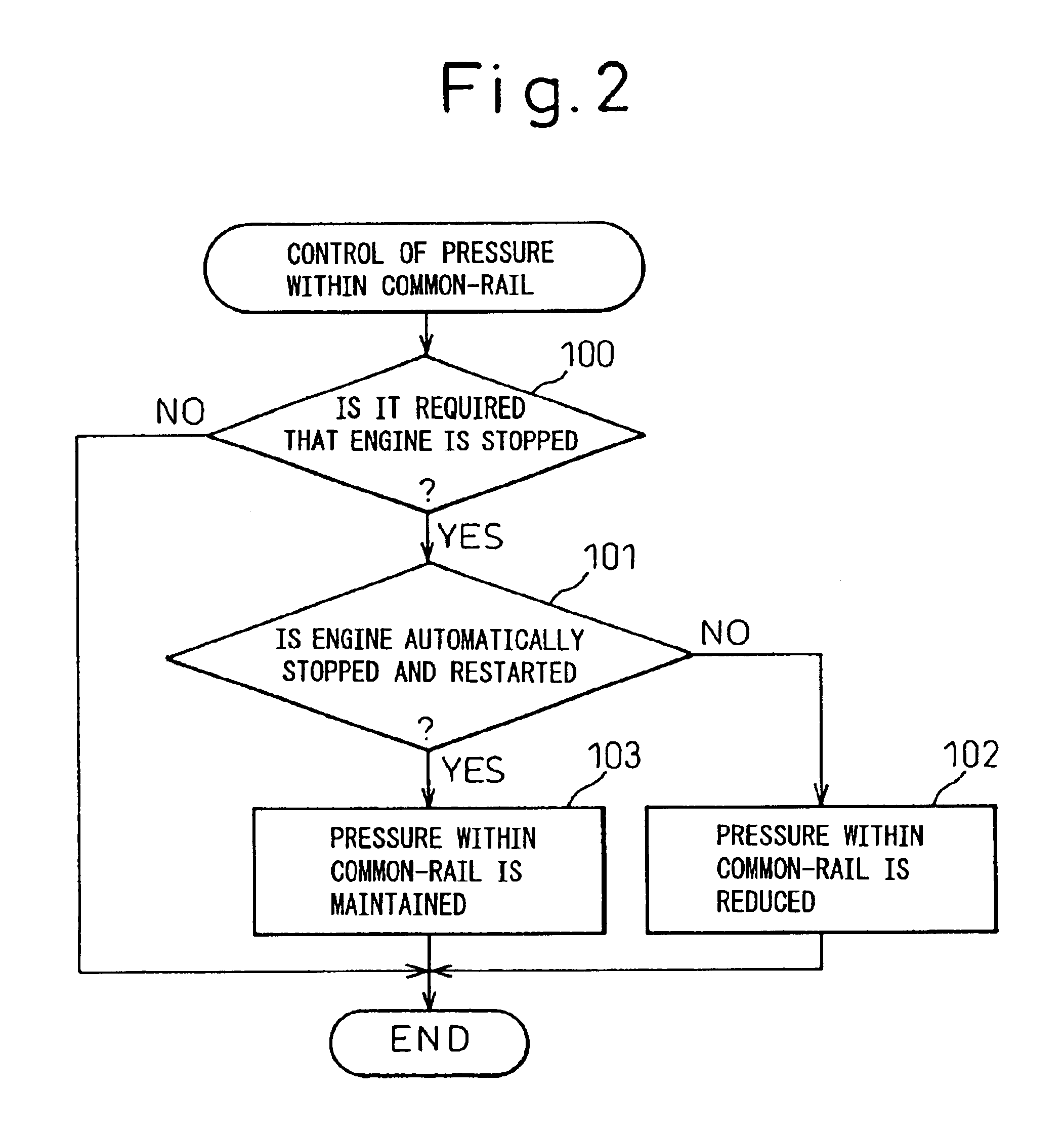Fuel injection controller of internal combustion engine
a technology of internal combustion engine and control device, which is applied in the direction of electric control, engine starters, machines/engines, etc., can solve the problems of engine restartability deterioration and fuel leakage from the common rail, so as to improve the restartability of the engine, improve fuel consumption, and reduce the pressure within the common rail
- Summary
- Abstract
- Description
- Claims
- Application Information
AI Technical Summary
Benefits of technology
Problems solved by technology
Method used
Image
Examples
first embodiment
[0020]FIG. 1 is a schematic construction view showing a fuel injection control device for an internal combustion engine according to the present invention. In FIG. 1, reference numeral 1 is an engine body, 2 is a fuel injector for injecting pressurized fuel, and 3 is a common-rail for accumulating pressurized fuel. Fuel is pressurized by a pump (not shown) to be supplied to the common-rail 3. Reference numeral 4 is a pressure-reducing valve 3 for reducing the pressure within the common-rail 3, 5 is a throttle valve, 6 is a intercooler, 7 is a turbo-charger, 8 is a catalytic system for purifying the exhaust gas, 9 is an EGR passage, and 10 is an EGR control valve. Reference numeral 11 is a pressure sensor for detecting the pressure within the common-rail 3, 12 is a vehicle speed sensor, 13 is an ignition switch, and 14 is an ECU (electronic control unit).
[0021]The fuel injection control device for an internal combustion engine of the first embodiment comprises an automatic engine sto...
second embodiment
[0030]Namely, in the second embodiment, the pressure within the common-rail 3 is reduced at step 203 before the engine is stopped with operating of the automatic engine stopping and restarting device. Namely, the pressure within the common-rail 3 is reduced at step 203 before the engine is restarted with an operation of the automatic engine stopping and restarting device.
[0031]The pressure within the common-rail 3 during the engine stopping is preferably maintained relative high to improve the engine restartability. However, when the engine was stopped, for example, immediately after an high speed running of the vehicle, and the pressure within the common-rail 3 at the engine stopping was considerably high, if the pressure within the common-rail 3 was not reduced, the combustion noise would become large and the amount of emitted HC would become large because the pressure within the common-rail 3 would be too high at the engine restarting. In view of this, according to the second emb...
third embodiment
[0037] when it is required that the pressure within the common-rail 3 during the engine stopping is not reduced to zero, if the pressure within the common-rail is higher than the target pressure within the common-rail, the pressure within the common-rail is reduced by the predetermined amount at step 203. In detail, when it is determined at step 300 that it is required that the engine is stopped with an operation of the automatic engine stopping and restarting device and it is determined at step 201 that the actual pressure within the common-rail is higher than the target pressure within the common-rail, the pressure-reducing valve 4 is actuated at step 203 and the pressure within the common-rail is reduced by the predetermined amount. Therefore, it can be prevented that the combustion noise becomes large and the amount of emitted HC becomes large at the engine restarting due to the high pressure within the common-rail at the engine restarting. Namely, the pressure within the common...
PUM
 Login to View More
Login to View More Abstract
Description
Claims
Application Information
 Login to View More
Login to View More - R&D
- Intellectual Property
- Life Sciences
- Materials
- Tech Scout
- Unparalleled Data Quality
- Higher Quality Content
- 60% Fewer Hallucinations
Browse by: Latest US Patents, China's latest patents, Technical Efficacy Thesaurus, Application Domain, Technology Topic, Popular Technical Reports.
© 2025 PatSnap. All rights reserved.Legal|Privacy policy|Modern Slavery Act Transparency Statement|Sitemap|About US| Contact US: help@patsnap.com



